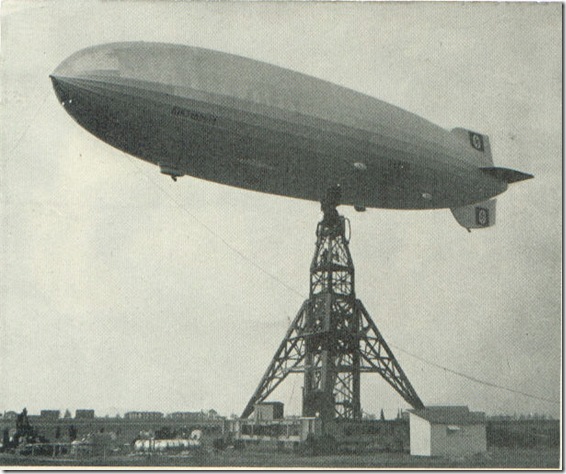LXVIII
It was starting to rain more heavily
again as at 7:17 P.M. on May 6, 1937, the Hindenburg
moved into position near the mooring mast at Lakehurst N.A.S.
 |
|
At 7:19 P.M on May 6, 1937, the Hindenburg dropped water ballast three
successive times as she tried to correct her trim. Her tail-heaviness is just
about noticeable in this picture
|
The ship was planning on accomplishing
a "flying" moor or a "high" moor, where it would be tied to
the mast while in flight and then winched down to the ground. It was a
technique the Americans had used regularly with the Shenandoah, the Los Angeles,
the Akron and the Macon, and, for that matter, with the Graf Zeppelin and the Hindenburg itself several times. It was
not the Germans' usual, or preferred, landing technique.
A sudden gust of wind pushed the big
dirigible out of its proper docking alignment.
According to "the book" the
Captain should have moved off, circled the field, and lined up again, but such
a maneuver would take about twenty minutes, a precious fragment of time in the Hindenburg's tight flying schedule.
And there was no guarantee that another
gust of wind wouldn't gum up the works again.
The ship still had to land its
passengers, refuel, reprovision, take on new passengers, lift off, fly to
Germany, repeat the process, and then repeat it again to reach London, all by
May 11th so that it could undertake its own questionable participation in the
Coronation of the new British monarch.
Of course, Pruss and Lehmann and the
other three captains aboard seemed to overlook one factor, that if the Hindenburg left Lakehurst in a timely
fashion --- it didn't have to be the helter-skelter one Pruss was set on --- it
would pick up the headwinds it had battled coming westward. Only now they would
be tailwinds speeding the ship toward Europe. There was every chance the Hindenburg could regain the twelve hours
it had lost.
But it never seemed to occur to anyone.
Captain Pruss decided to ignore the
book. He ordered hard-a-starboard, and the ship veered --- very hard, in what
has been described as a tight "S" --- over toward the waiting mooring
mast. It was 7:18.
This wasn't a misdemeanor, a felony, or
even an invitation to disaster. After all, there was nothing in the book about flying
blind through the Stanovoy Mountains, tipping a ship on its tail and then its
nose to overfly electrical wires that could have caused a mass-destruction
event, or traveling to the North Pole, and Dr. Eckener had done all of that in
the Graf Zeppelin.
But Pruss wasn't Eckener and the Hindenburg was not the Graf Zeppelin.
A few moments later, the ship's
commutator showed her down at the stern. Pruss ordered hydrogen valved from the
bow, and then three ballast dumps totaling nearly 3,000 pounds of water, over
the next minute in order to bring the ship level. When nothing seemed to work,
he ordered a half-dozen men into the nose. Finally, at about 7:20, she evened
out.
 |
|
7:20 P.M.: A seaman giving directions
to Captain Pruss as the Hindenburg
nears the mooring mast. Note the assembled ground crew
|
What had happened should have alerted
the bridge to a very serious problem. Somewhere aft the ship was losing
buoyancy. And it was losing buoyancy because it was losing hydrogen. But,
oddly, no one on the bridge recognized the problem.
Pruss went on trying to land his ship.
If anything could have been done to save her, the opportunity was leaking away
by the moment along with the ship's lifting gas.
It was at this point that people on the
ground noticed an odd "flutter" at the very top of the ship's
envelope just ahead of her upper vertical stabilizer. A few wondered what it
was. Fewer realized that they were watching lighter-than-air gas escaping
through the Hindenburg's fabric skin.
At 7:21, Pruss ordered the hemp mooring
lines dropped from the nose and the stern. The ropes snaked down through the
rain and landed with splatting noises as they hit the drenched earth. After a
few moments, the ground crews picked them up and began working with them. They
were pulling the ship toward the mast. They made her fast and began to winch
her down toward the ground.
From the gondola, Captain Pruss waved to
Commander Rosendahl who had come outside to watch the landing. Waiting family
members called up to familiar faces at the Promenade windows. The ship was
coming closer to the ground.
 |
|
7:25
P.M.: The last known photograph of the intact Hindenburg. Note the mooring line trailing from the bow
|
Four minutes later, they all heard a dull pop, "like the burner of a gas stove being switched on."
 |
|
An
eyeblink later . . .
|
This comment has been removed by a blog administrator.
ReplyDeleteThis comment has been removed by a blog administrator.
ReplyDelete